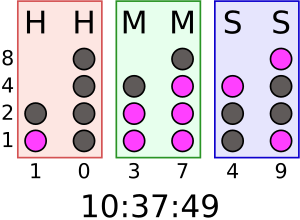Place value facts for kids
Place value is a super important idea in mathematics. It tells us how much a digit is worth based on where it sits in a number. Think of it like a digit's address in a number. The same digit can mean very different things depending on its place.
For example, in the number 555, each '5' has a different value. The '5' on the far right means 5 ones. The middle '5' means 5 tens, or 50. The '5' on the far left means 5 hundreds, or 500. This idea helps us understand and work with very large and very small numbers easily.
Contents
Understanding the Decimal System
Our everyday number system is called the decimal system. It's also known as base 10. This is because it uses ten different digits: 0, 1, 2, 3, 4, 5, 6, 7, 8, and 9. Each place in a number is ten times bigger than the place to its right.
What are the place values?
Let's look at the places around the decimal point. The decimal point separates whole numbers from parts of a whole.
- To the left of the decimal point:
* The first spot is the ones place (or units place). * The second spot is the tens place. * The third spot is the hundreds place. * The fourth spot is the thousands place, and so on.
- To the right of the decimal point:
* The first spot is the tenths place. * The second spot is the hundredths place. * The third spot is the thousandths place, and so on.
You can imagine it like this: Thousands | Hundreds | Tens | Ones . Tenths | Hundredths | Thousandths (Th) | (H) | (T) | (U) . (t) | (h) | (th)
How does place value work in numbers?
Let's take the number 4,321.678 as an example:
- The 4 is in the thousands place, so it means 4 x 1,000 = 4,000.
- The 3 is in the hundreds place, so it means 3 x 100 = 300.
- The 2 is in the tens place, so it means 2 x 10 = 20.
- The 1 is in the ones place, so it means 1 x 1 = 1.
- The 6 is in the tenths place, so it means 6 x 0.1 = 0.6.
- The 7 is in the hundredths place, so it means 7 x 0.01 = 0.07.
- The 8 is in the thousandths place, so it means 8 x 0.001 = 0.008.
When you add all these values together (4000 + 300 + 20 + 1 + 0.6 + 0.07 + 0.008), you get the original number 4,321.678. This shows how each digit contributes to the total value of the number.
Other Number Systems
While the decimal system is what we use every day, other number systems also use place value. They just use a different "base" or number of digits.
Binary System (Base 2)
The binary system is a base-2 system. It uses only two digits: 0 and 1. This system is super important for computers because they understand things as "on" (1) or "off" (0). In binary, each place value is two times bigger than the one to its right.
For example, the binary number 101 means:
- The first 1 (from the left) is in the "fours" place (2x2).
- The 0 is in the "twos" place.
- The last 1 is in the "ones" place.
So, 101 in binary is (1 x 4) + (0 x 2) + (1 x 1) = 4 + 0 + 1 = 5 in our decimal system.
Hexadecimal System (Base 16)
The hexadecimal system is a base-16 system. It uses 16 different symbols: 0-9 and then A, B, C, D, E, F to represent values from 10 to 15. This system is often used in computer programming and web design.
Why is Place Value Important?
Place value is a fundamental concept in math. It helps us:
- Read and write large numbers: Imagine trying to write "one million" without place value!
- Perform calculations: Adding, subtracting, multiplying, and dividing numbers relies on understanding the value of each digit.
- Understand decimals and fractions: Place value extends to numbers smaller than one, helping us work with parts of a whole.
- Work with different number systems: It's the core idea behind how computers process information.
Related pages
Images for kids
See also
 In Spanish: Notación posicional para niños
In Spanish: Notación posicional para niños



